- Occasionally I recycle a favorite older post because very few current readers have ever seen it. I published this one on February 19, 2012 and I believe the images were taken in the early summer of 2011 (no time to look it up right now). I’ve rewritten some of the text and cleaned up the formatting. Some of the images are slightly oversharpened – back then my processing skills were somewhat lacking.
In previous posts about this Short-eared Owl pair at Red Rock Lakes National Wildlife Refuge in sw Montana I’ve shown and described snippets of the fascinating behaviors I observed when this male would deliver voles to the female and two youngsters at the nest. But it struck me that I’ve never put the whole process together in sequence so the behaviors could be fully appreciated so that’s what I’ll attempt to do here. Most of the images will be different from those in the previous posts though some will be similar.
1/1250, f/5.6, ISO 800, 500 f/4, 1.4 tc
The male was a tireless and highly skilled hunter and I never saw him with any prey other than voles. When successful he would nearly always return to the vicinity of the nest and land momentarily on one of two favorite perches – the darker sagebrush at lower right in the above photo or a metal post a few feet from the sagebrush. Here he’s coming in for a landing on the sagebrush with a vole in his talons and glancing up at me to make sure all is safe. I really like the intense direct eye contact.
1/1000, f/5.6, ISO 800, 500 f/4, 1.4 tc
Now he’s focused on the sagebrush in order to make a successful landing.
1/1250, f/5.6, ISO 800, 500 f/4, 1.4 tc
This time he stayed perched for less than five seconds and didn’t even pull his wings in against his body – he just kept them out or up while he seemed to contemplate his next move. And I knew what that next move would be because he always did the same thing – transfer the vole from talons to beak either just before or during take-off to deliver the vole to his family at the nest. The nest is at the base of another sagebrush to the left of the sagebrush and perhaps 70 yards out of the frame.
1/1000, f/5.6, ISO 800, 500 f/4, 1.4 tc
He glanced my way once again…
1/1250, f/5.6, ISO 800, 500 f/4, 1.4 tc
and in a single fluid motion he took off and transferred the vole from talons to beak.
1/1600, f/5.6, ISO 800, 500 f/4, 1.4 tc
Liftoff and headed toward his mate and two youngsters at the nest.
1/2000, f/6.3, ISO 640, 500 f/4, 1.4 tc
This is when things get a little dicey for the male because delivering the vole to the female is a scary proposition (I’ll try to avoid being excessively anthropomorphic but it won’t be easy). Here he’s quite close to the nest entrance and as he approaches she becomes aggressive and he’s obviously wary of her. He’s timid and cautious in his approach – after all, due to sexual dimorphism she’s about 20% larger than he is in body mass.
1/1600, f/6.3, ISO 640, 500 f/4, 1.4 tc
When he gets close to the nest the female aggressively rushes out at him and he instantly drops the vole and doesn’t make eye contact (as she does in an intimidating manner). Usually he would then fly off immediately but this time he timidly stood his ground. The vole is in the grass directly between their faces but the female just glares at him, seeming to dare him to make a move toward the vole he’s just dropped. This time he backed out before flying off and then she grabbed the vole and took it back into the nest and the two chicks.
1/2500, f/6.3, ISO 500, 500 f/4, 1.4 tc
I only got a good look at one of the youngsters this one time over several days of photographing them, though it was obvious there were two chicks in the nest. You’ll notice from the light and my camera settings that this is one of the few times the sun came out while I was photographing these owls so it’s my suspicion that she brought the youngster out into the sun to catch a few warming rays.
1/2000, f/6.3, ISO 640, 500 f/4, 1.4 tc
This is the other “favorite perch” of the male – an ugly metal post that served no apparent purpose on the refuge. I’m glad that he seemed to like the sagebrush as well as he did the post. Here he’s just landing after returning from one of his rare unsuccessful hunting forays.
1/2000, f/6.3, ISO 640, 500 f/4, 1.4 tc
But far more often than not he had a vole with him when he landed on either perch. In this shot he’s already transferred the vole to his beak and is about to take off for the nest (and yes, that’s a bee on the left flying toward the owl).
Preparing this post has brought back a flood of wonderful memories of my times with these owls. Hopefully there’ll be more of them in the relatively near future.
Ron
Note*** I’d like to make it clear that I was very careful not to disturb these birds in any way. I was shooting from a road from inside my pickup with a supertelephoto lens (effectively at 1120 mm with the tc and crop factor of the 7D and these images have been significantly cropped) and I never once got out of my pickup anywhere near the nest. The owls were acclimated to vehicles on the road and they never seemed disturbed by my presence. If they had been I’d have left the area. And as always there was no baiting or setting up involved.
Regular readers probably get tired of hearing that message but I think it’s important to include for novice bird photographers and those who are new to my blog.


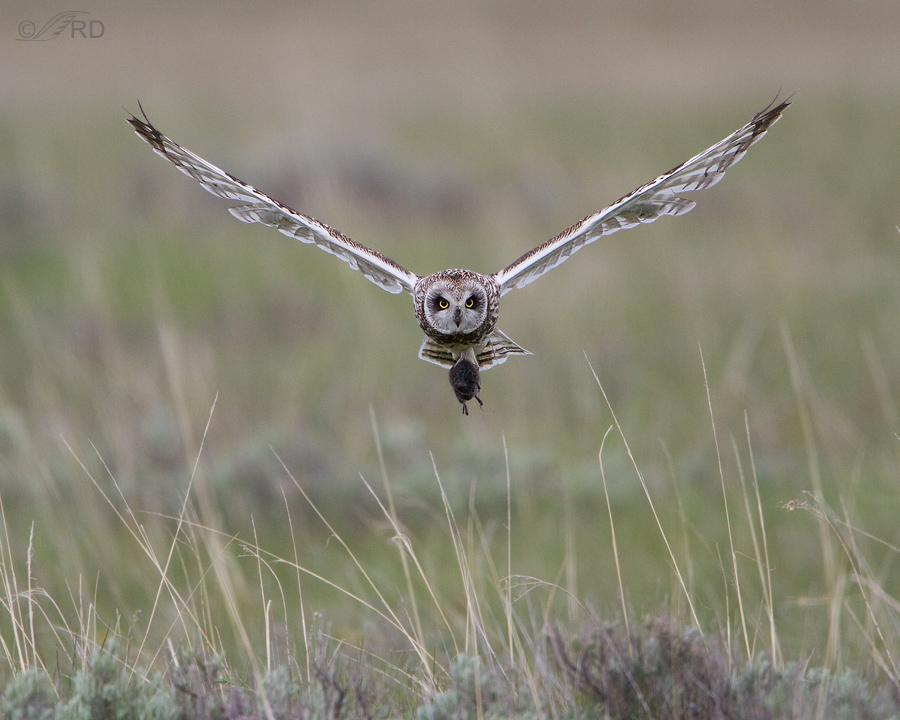
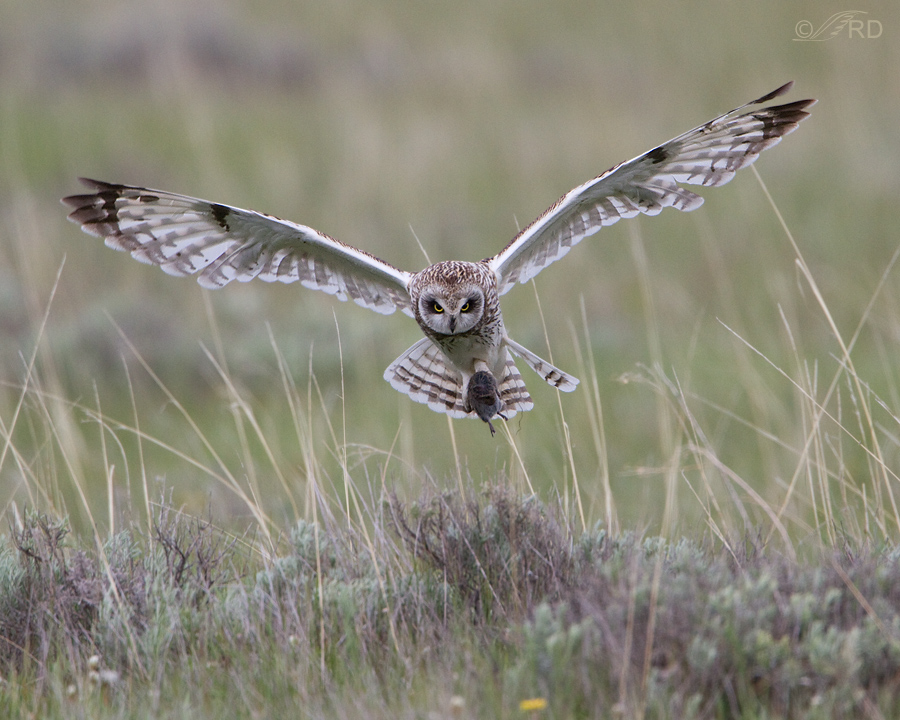
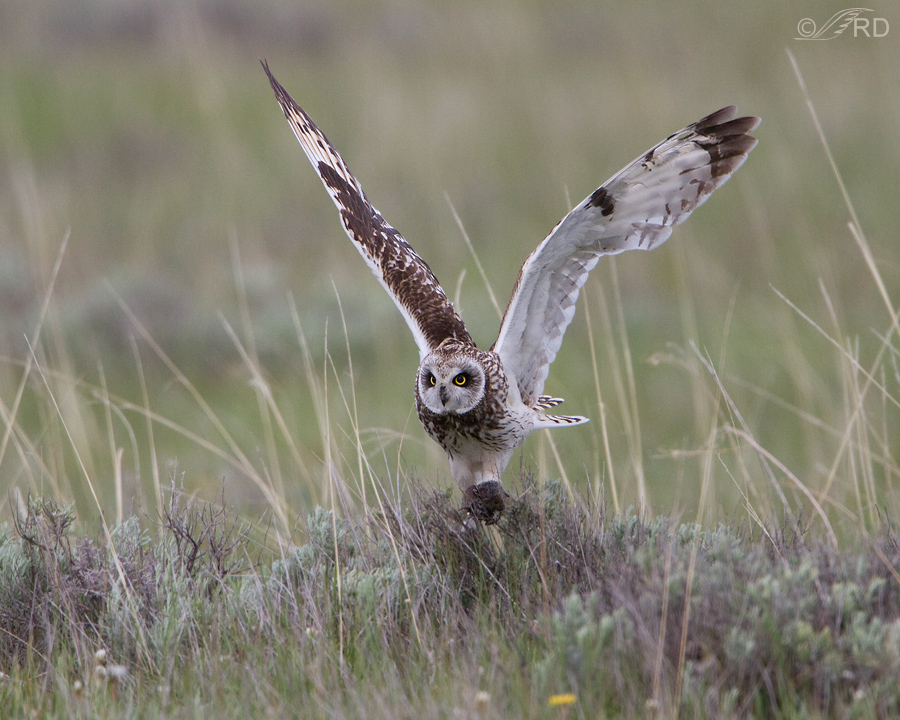
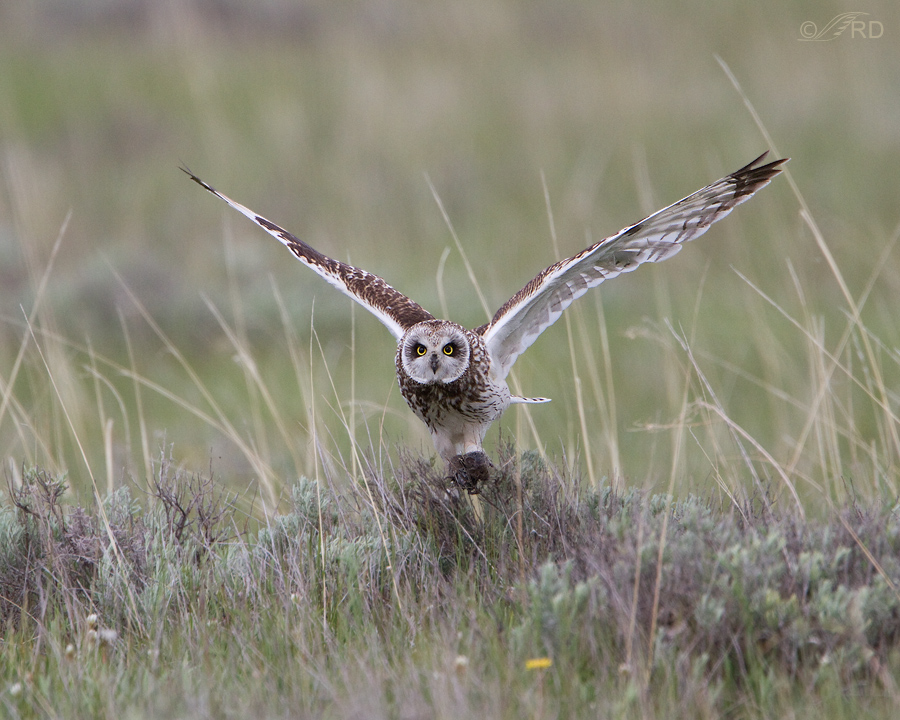
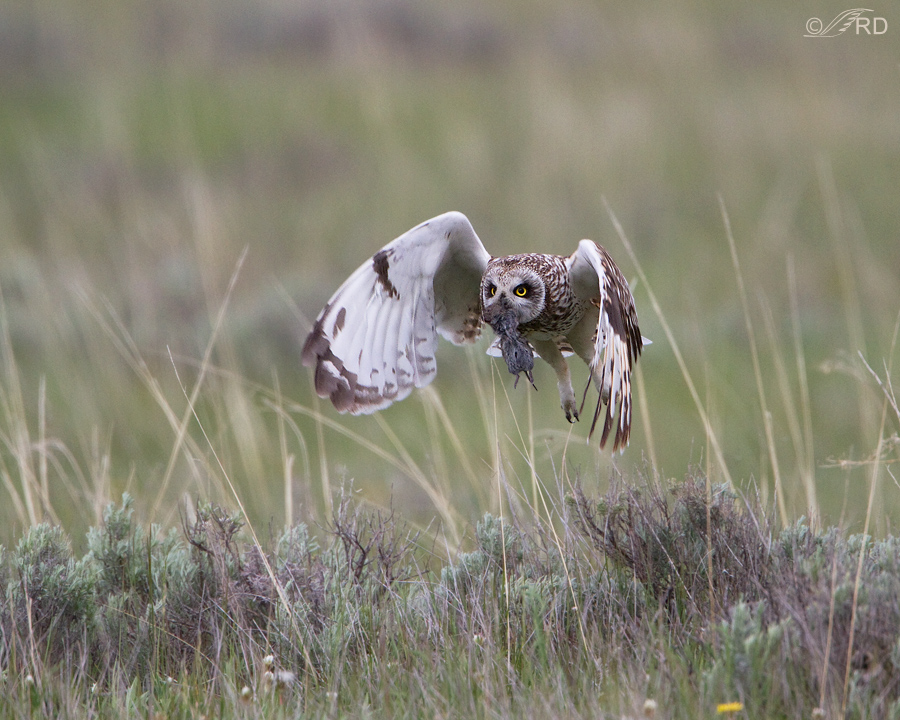
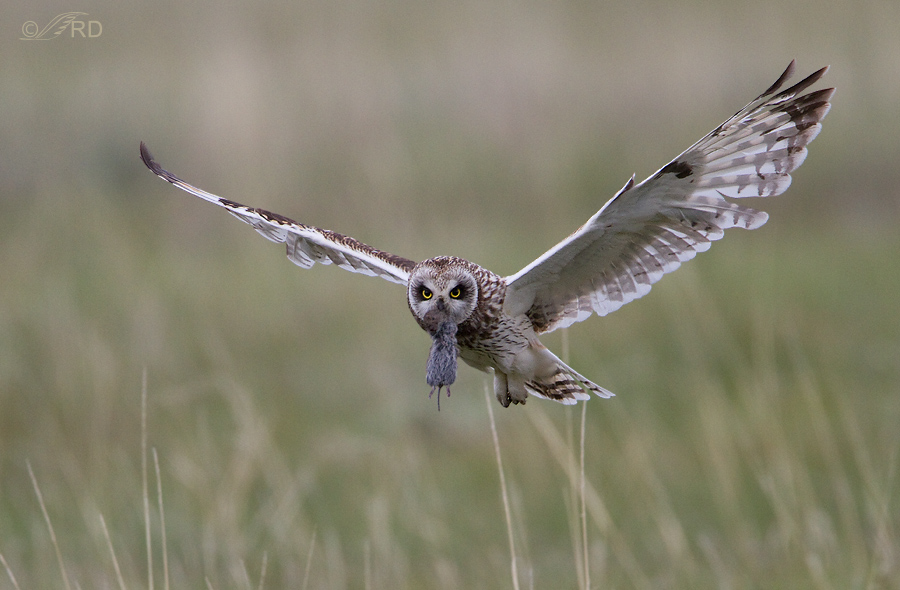
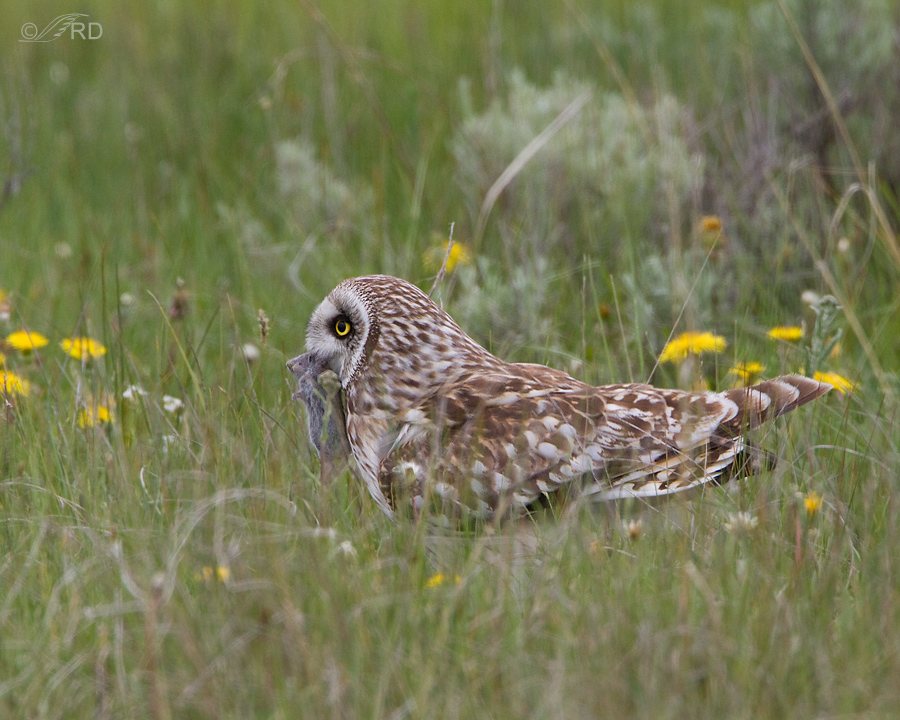
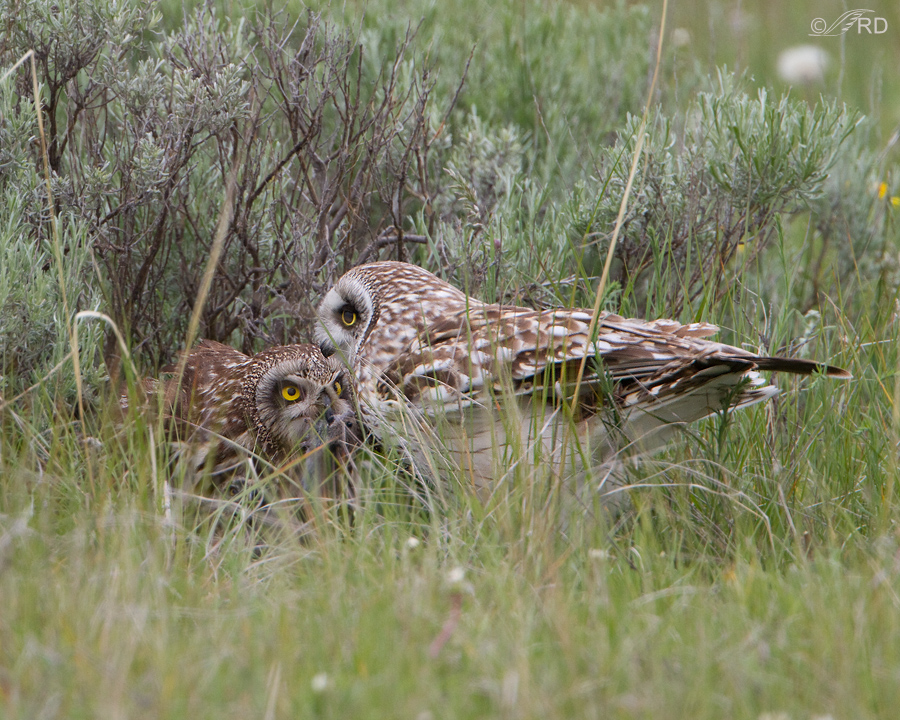
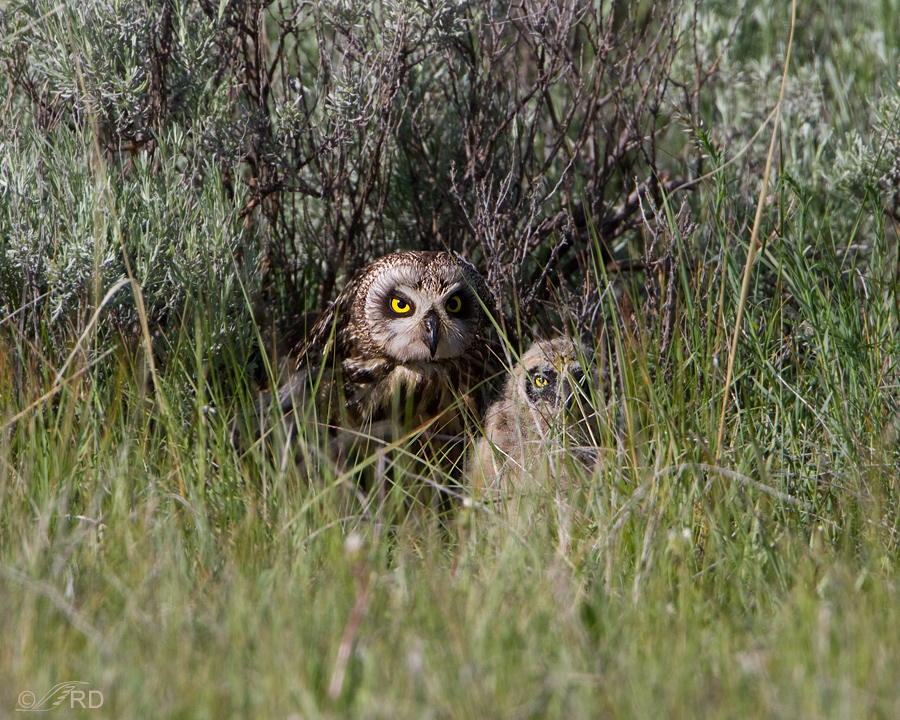
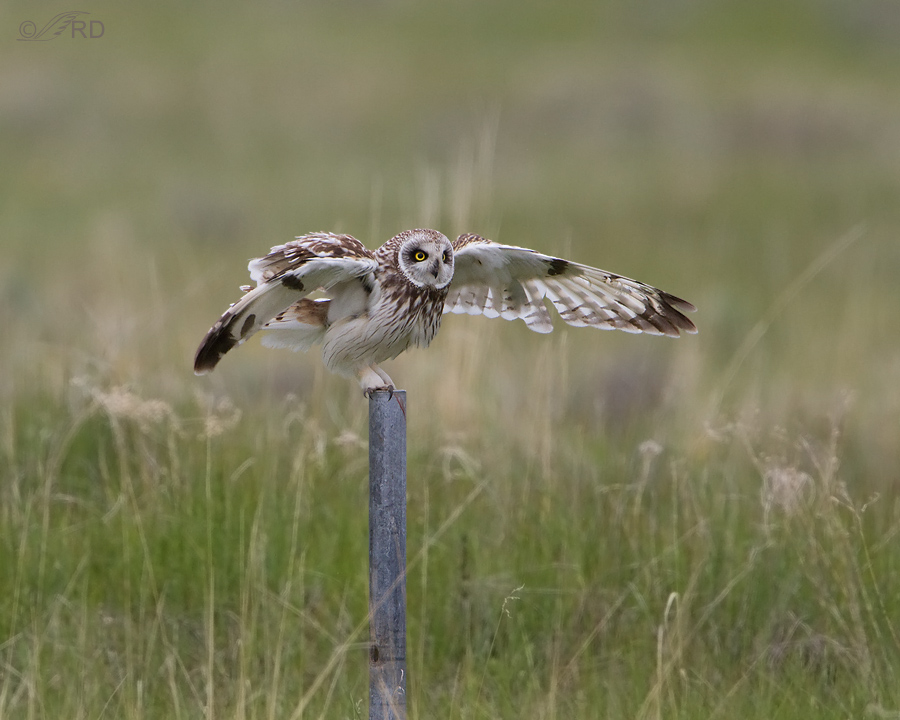
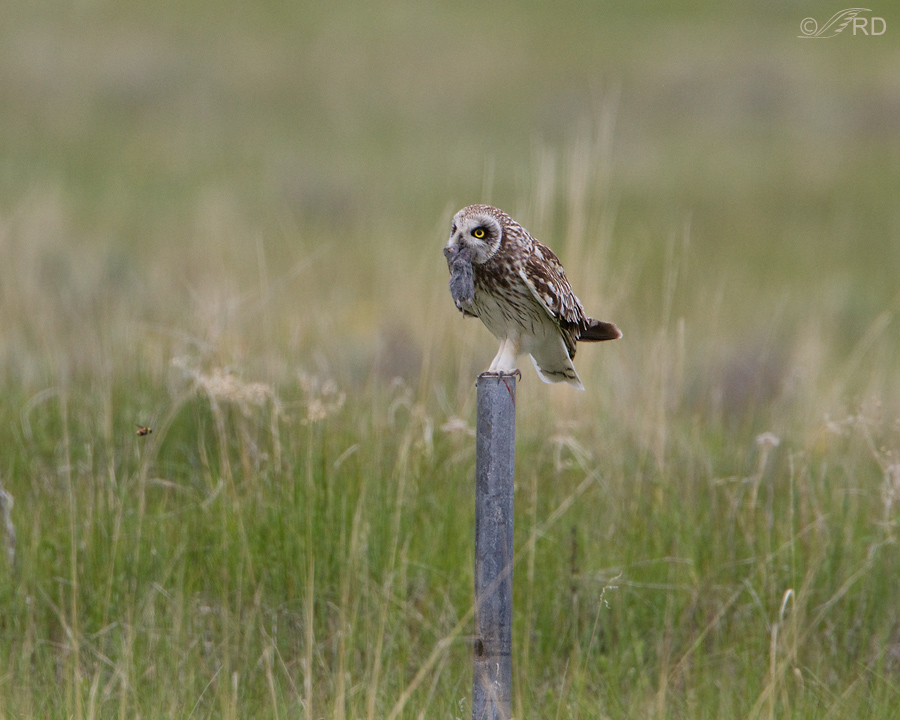
I’m late to the party because we just got home this evening from our 2-month trip. I’m really glad you recycled this post because the photos are beautiful, and that story that goes with them is interesting. I sometimes wish people would have the ability to persist through unpleasantness the way this owl does with his mate. I’m sort of surprised that she would be so aggressive toward him, since it seems like all he ever did was deliver food.
I was surprised too, Susan.
Today I watched as a male Red-tailed Hawk delivered food to his mate on the nest and compared it to this situation. Her reaction was completely different – accepting and welcoming. Understanding the ways of nature and how/why they evolved often doesn’t come easy.
That first shot is so striking! Wow! It makes me wonder if he’s the same fella in the entrance picture to your blog. That wingspan is something else! Is he missing a tail feather? I see a gap, but I’m not sure if it is just the way he’s got them spread.
And the fuzzbutt chick makes me giggle. Until I see mama, that is. Then I just want to get the hell out of there!
I’ve always been partial to GHOs and I thank you for turning me on to the wonder and beauty that is the SEO. 🙂
I’m pretty impressed…beautiful images…great story told…
Thank you, Steve – on both counts.
Wunnaful. Really wunnaful.
And today I may practise ‘stink eye’ until I have it right. I can see a LOT of advantages if I perfect that look.
You made me smile again, EC. Yes, getting that look right could definitely have its rewards!
Whenever I tried stink eye on my students, they laughed…very disappointing…I was hoping for guilty cringing and squirming…now I use it with greater effect on totally obnoxious,uncontrolled, spoiled little brats encountered in public places…If I’m really successful(and lucky), they wither…..
Patty, with some practise we will make rather a lot of people wither.
We had a whole session on looks that could stop a student in his or her tracks in one of the courses for my credential. I can’t remember whether it was my science methods course or my classroom management course, but I’m thankful that I learned to burn a hole in misbehaving student with my laser vision. Mwahaha. 😉
EC never underestimate the power of stink eye! It certainly makes me back up and reassess the situation! And when I give it, it has the same effect on humans. Mariah taught me! 🙂
Love the pictures. Thanks Ron!
Thank you, Jean.
Fabulous Post, Ron. I love the images and the narrative. It was almost as thrilling for me as it would have been to experience it in person (almost). 😉
I’m glad you enjoyed the series that much, Sharon. Thanks for letting me know.
Superb stuff! Photographic quality, bird behavior, education. It’s all here. Again. Thank you for the continuing motivation to try and improve my hobby.
Don’t stop reminding us of what should be “common” sense about not disturbing wildlife. I was almost trampled just the other day by a “photographer” trying to get a shot of a perched Snail Kite. He had to transition to trying to get a shot of a “Snail Kite in flight” since he scared it off the perch. Sigh.
(I have decided to stop apologizing for not visiting for so long as I am obviously an irresponsible twit who can’t adhere to any sort of schedule and will likely repeat the offense ad infinitum.)
(But is sure is nice here when I do drop in!!)
I’m glad to hear you don’t roll your eyes every time you see that disclaimer about nest ethics, Wally. It has to get old for regular readers but I just can’t see not including it when there’s a nest involved.
Amazing behavior from the female. Maybe the male showed up late and she was angry!! Who knows….As usual, great photos.
Alice, One time (and one time only in the days I was there) the male took a long time to bring the vole in to the nest. She called to him in frustration to bring it but he stayed on the pole with it. Eventually she shot out of the nest and went after him for it. Got it too, and took it to the chicks.
You are an amazing photographer! I know how hard it is to get such shots. I especially appreciate the behavior notes you include. I had no idea about the female’s domination at the nest.
Thank you for the fine compliment, Buff. I don’t know if her behavior was typical for the species but I suspect it is.
I hate to be so darn repetitive, but just WOW! What an utterly SPECTACULAR series of outstanding shots. Yes, I know you’ll quibble about minor flaws and things, but just don’t! Both from photographic and behavioral perspectives, these are simply wonderful (she said repetitively).
Jack, “my” Harris’ hawk who is no more mine than the air I breathe, LOVES voles. He says they’re tasty treats, and with the absence of cottontails where we lived in New York, he enjoyed doing his civic duty ridding the world of small rodents.
However, Jack often struggles with the Yes-Dear concept when he’s out with female Harris’ hawks. He ultimately gets that his answer is always Yes Dear, but the females often have to remind him of his place in the Harris’ hawk hierarchy. This male obviously has his priorities in the right place.
And yes, Momma rules the roost. Don’t even THINK about challenging her. Overall, it’s not wise to mess with mothers. They will (generally) hurt you when the kids are involved.
Never fear, Laura, I certainly don’t mind your “repetitiveness”! 🙂 Thank you.
Talk about “stink eye”!!! It’s amazing that he dares to get that close!!! He’d make a great meal for those chicks…and I think he knows it!!! A wonderful series…(would be happy to see it repeated many more times)…that metal pole may not serve any purpose for us, but uncomfortable a perch as it looks, that owl seems to appreciate it…(better than nothing when there aren’t any trees handy)…got a kick of the baby’s round-eyed innocence and the mama’s threatening owl scowl….
Patty, that metal pole may have been the instigator that allowed me to start appreciating unnatural perches in the first place. For several years I wouldn’t tolerate them in my images.
FYI, that post is still there after this many years. It helps me to remember where the nest was when I go back to the Centennial.
Great behavioral and flight shots Ron. I particularly like shots 1,2,4 ,and 6. I can just imagine the fun you had, and don’t fret about reminding everyone about your photographic ethics, that is the reason you have such a following!!
I didn’t know Sagebrush is tough enough to hold the weight of an owl. And, i also didn’t realize how intimidating the female can be towards her mate. Many thanks for these daily lessons!! Nature is vast and it is all about learning and understanding for a greater appreciation.
You’re right about the “fun”, Dick. I spent 3 or 4 days with them that trip and it was one of the most memorable experiences of my life – involving birds or not involving birds.
Thank goodness for strong instinct ! If that male had to depend upon gracious thanks for his dedication, those babies would go hungry !
Well said, Kris.
What a remarkable series of photographs! Incredible. Thanks for your gift of this images, -Joel
Thank you, Joel.
This was awesome Ron! So the female is afraid the male owl would eat or harm his own babies? I didn’t know that. She looked fierce when he was near!
Barby, I’m not sure she thought he’d harm the chicks. It seemed more to me like she was warning him not to make an attempt to take the vole back.
Wonderful way to start the day! Thanks, Ron!
Thank you, Diane.
Wonderful series, Ron! 🙂 The vole certainly reminds one of the size of the owl which isn’t very big really. Interesting that the female is the “give me the food and get the hell out of here” type. 🙂 Male has to be VERY highly motivated to deal with that. 🙂 I never tire of the reminder and hope the word keeps spreading……………. The one GHP fuzz ball I can see here is starting to “bobble head” – such fun.:)
Yup, she had him buffaloed, Judy and he sure knew his place!
Awesome series! Thanks for these photos.
Thank you, Elmer.
Ron, you have outdone yourself again. Spectacular series 🙂
As usual the birds get much of the credit, Dominique. Thanks.
Amazing series. Tells a great story
Thank you, Alan.
Awesome series Ron!
Charlotte
Thanks, Charlotte.
Great series of photographs again. What exquisite birds! The more I observe these amazing creatures myself, and the more I look and learn from the generous teachings of photographers and naturalists online (kudos to you), the more charmed I become by these feathered beings who are so different from us. It is also remarkable how much birds themselves differ from species to species I feel for the voles though… life sure is a bitch.
Yes, exquisite is a fitting word for them Joanne.
NICE series!
Thanks, Marie.